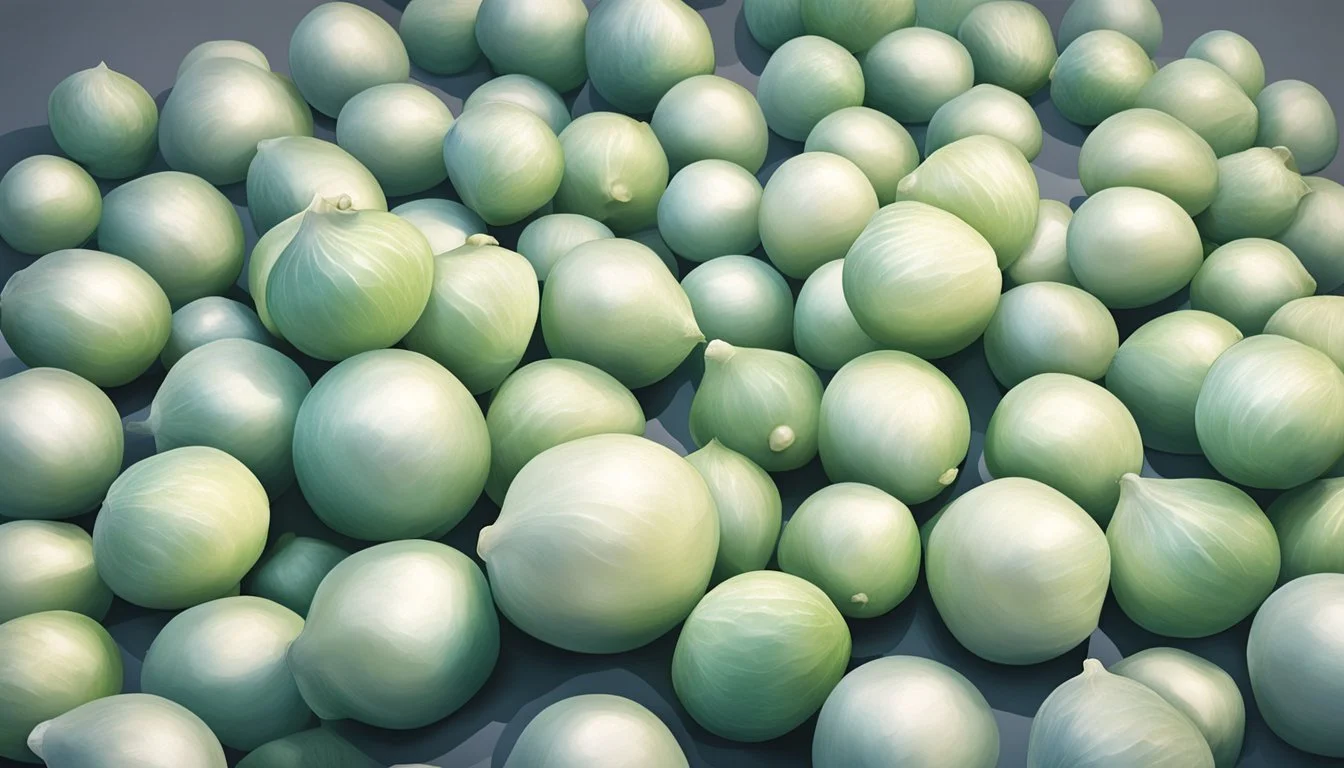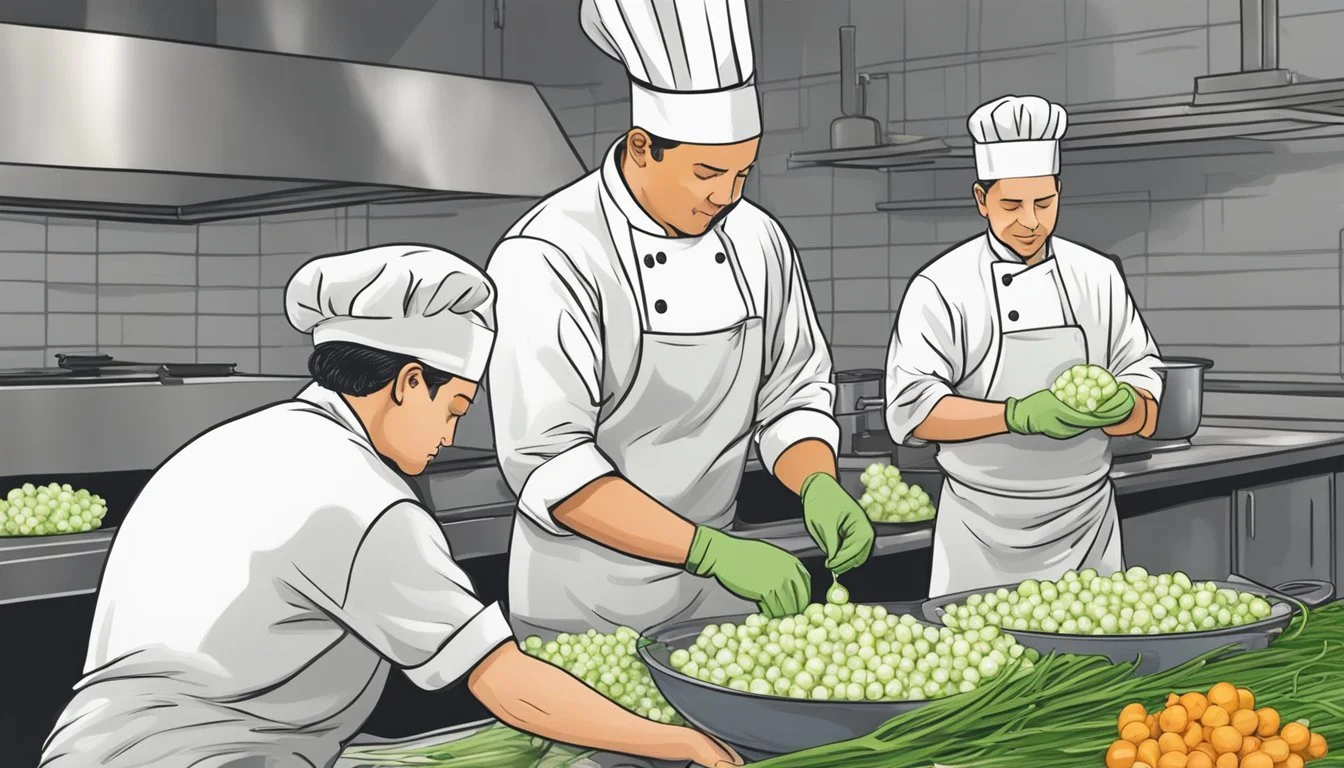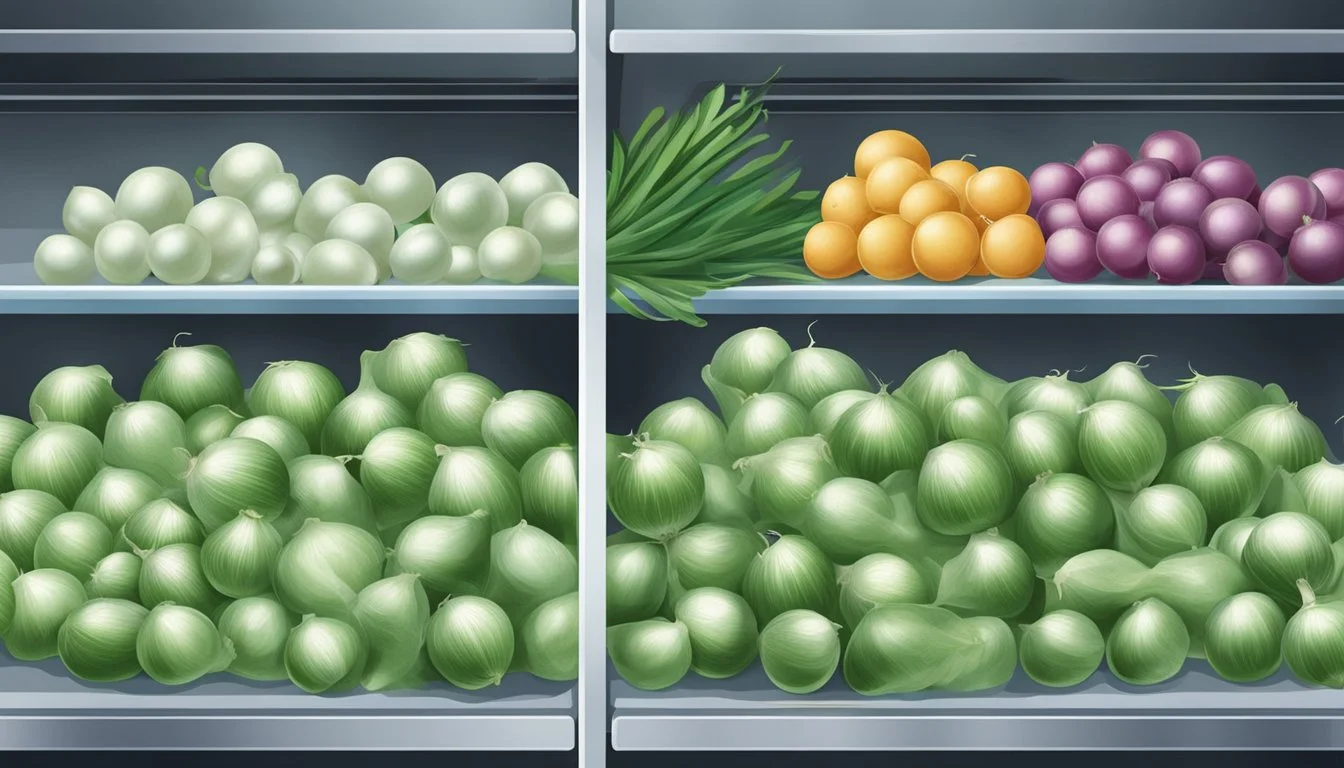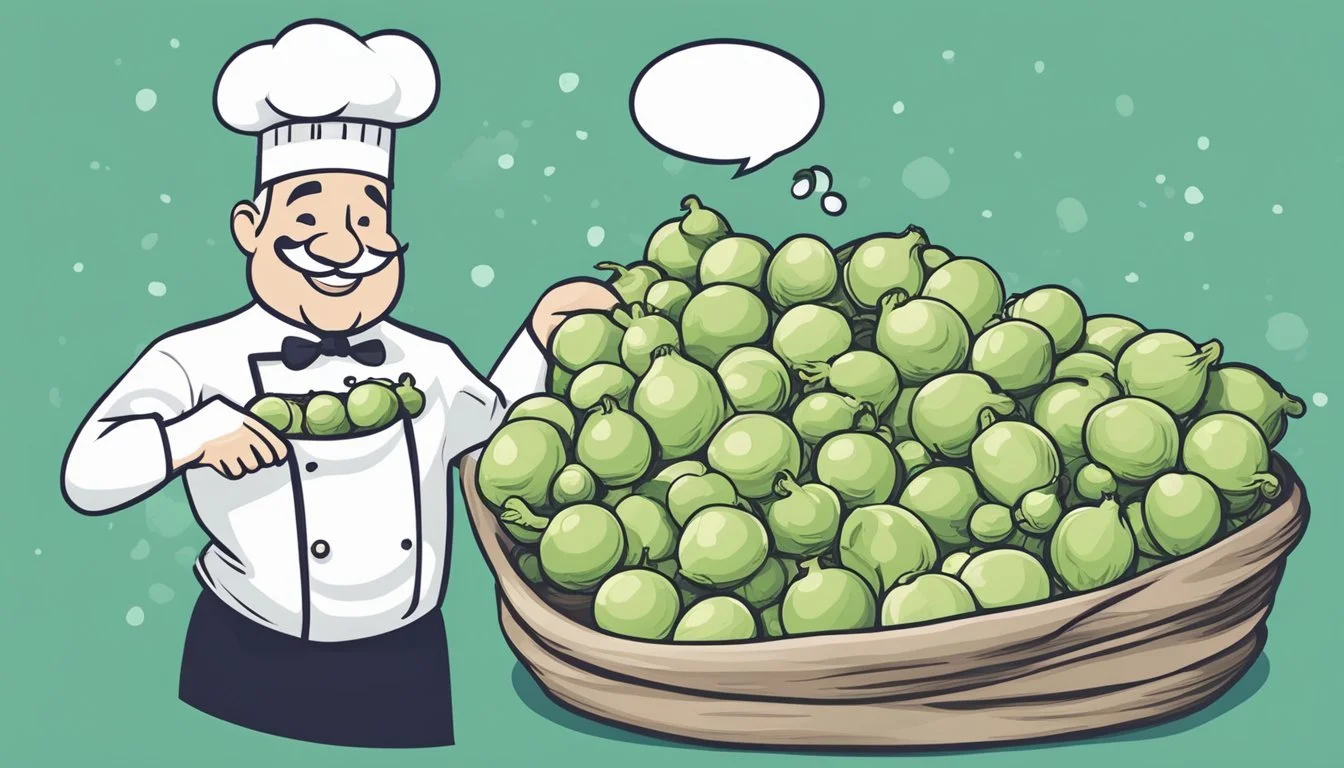Frozen vs Fresh Pearl Onions: Tiny Alliums Compared
Pearl onions add a delightful flavor to many dishes, but preparing fresh ones can be time-consuming. Frozen pearl onions offer a convenient alternative, eliminating the need for peeling and reducing prep time in the kitchen.
Frozen pearl onions are generally just as good as fresh ones for most cooking applications. They maintain their nutritional value and flavor when properly frozen and stored. Many chefs use frozen pearl onions in soups, stews, and sauces without compromising taste or quality.
While fresh pearl onions may have a slightly firmer texture, the difference becomes negligible once cooked. Frozen varieties are typically pre-peeled, saving valuable time in the kitchen. This convenience factor, combined with their long shelf life, makes frozen pearl onions a practical choice for many home cooks and professional chefs alike.
Pearl Onion Varieties and Characteristics
Pearl onions come in several varieties, each with unique traits. These small alliums offer distinct flavors and uses in both fresh and frozen forms.
Types of Pearl Onions
Pearl onions are available in white, red, and golden varieties. White pearl onions have a crisp texture and mild, sweet flavor. Red pearl onions provide a slightly sharper taste and vibrant color. Golden pearl onions offer a delicate, subtly sweet profile.
Each type ranges from 1/2 to 1 1/2 inches in diameter. Their small size makes them ideal for roasting, pickling, or adding whole to dishes.
Fresh Pearl Onions
Fresh pearl onions have a firm texture and crisp bite. Their outer papery skin must be removed before use, which can be time-consuming.
These onions offer a more pronounced flavor compared to their frozen counterparts. When cooked, fresh pearl onions develop a sweeter taste and tender texture.
They're excellent for glazing or caramelizing, as their natural sugars concentrate during cooking.
Frozen Pearl Onions
Frozen pearl onions provide convenience without sacrificing much quality. They come pre-peeled and ready to use, saving preparation time.
While slightly less pungent than fresh, frozen pearl onions maintain a similar flavor profile. They work well in soups, stews, and casseroles.
Frozen varieties may lose some crispness but retain their shape during cooking. They're particularly useful for dishes requiring longer cooking times.
Nutritional Profile of Pearl Onions
Pearl onions pack a nutritional punch despite their small size. These tiny alliums offer various vitamins and minerals that contribute to a healthy diet.
Vitamins in Pearl Onions
Pearl onions contain vitamin C, an antioxidant that supports immune function and skin health. A 100-gram serving provides about 7.4 mg of vitamin C, or 8% of the daily value. They also offer small amounts of B-vitamins, including folate and vitamin B6.
These onions provide vitamin K, essential for blood clotting and bone health. A serving contains approximately 0.4 mcg of vitamin K.
Pearl onions contain trace amounts of vitamin E, which acts as an antioxidant in the body.
Frozen vs Fresh Nutrient Content
Frozen pearl onions retain most of their nutritional value compared to fresh ones. The freezing process preserves nutrients effectively, with minimal losses.
Vitamin C content may decrease slightly in frozen onions, but the difference is generally negligible. Other nutrients like fiber and minerals remain largely intact.
Frozen pearl onions offer convenience without significantly compromising nutritional quality. They provide similar health benefits to fresh ones, making them a practical choice for many recipes.
The texture of frozen onions may differ slightly from fresh, but their nutrient profile remains comparable. This makes them a viable option for health-conscious consumers seeking convenience.
Preparing Pearl Onions
Pearl onions require some preparation before cooking, whether using fresh or frozen. The key steps involve peeling fresh onions or thawing frozen ones properly.
Peeling Fresh Pearl Onions
Fresh pearl onions need peeling before use. Start by trimming off the root end with a paring knife, leaving just enough to hold the layers together. Score an X on the opposite end.
Bring a pot of water to a boil. Drop the onions in for 30 seconds, then transfer to an ice bath. Once cool, the skins should slip off easily by pinching the scored end.
For large batches, boil the onions in smaller groups to maintain water temperature. This method preserves the onion's shape and texture while making peeling much simpler.
Thawing Frozen Pearl Onions
Frozen pearl onions come pre-peeled, saving significant prep time. To thaw, place the desired amount in a colander and run cool water over them for a few minutes.
For recipes requiring more immediate use, place frozen onions in a microwave-safe bowl. Heat in 30-second intervals, stirring between each, until thawed.
Avoid thawing pearl onions at room temperature, as this can promote bacterial growth. Instead, thaw in the refrigerator overnight for the best food safety practices.
Once thawed, pat the onions dry with paper towels before using in recipes. This step helps prevent excess moisture from affecting cooking times or dish consistency.
Cooking Techniques for Pearl Onions
Pearl onions can be prepared using various cooking methods to enhance their flavor and texture. Each technique brings out different qualities in these small, sweet onions.
Boiling and Blanching
Boiling pearl onions softens their texture and mellows their flavor. To boil, place onions in salted water and cook for 3-5 minutes until tender. Blanching involves briefly boiling then shocking in ice water. This technique is useful for peeling fresh pearl onions.
Score an X on the root end, boil for 30 seconds, then plunge into ice water. The skins will slip off easily. Blanching also helps retain color and crisp texture when freezing pearl onions for later use.
Many chefs prefer this method as a first step before other cooking techniques. It ensures even cooking and removes any harsh flavors.
Sauteing and Caramelizing
Sauteing pearl onions in butter or oil over medium-high heat caramelizes their natural sugars. This creates a rich, sweet flavor and golden-brown color. Heat oil in a pan, add peeled onions, and cook for 8-10 minutes, stirring occasionally.
For deeper caramelization, lower the heat and cook longer, up to 20-25 minutes. Add a pinch of sugar to enhance browning. Deglaze the pan with wine or broth to create a flavorful sauce.
Caramelized pearl onions make an excellent side dish or addition to stews and braises. Their concentrated sweetness complements savory meats and vegetables.
Braising and Roasting
Braising involves cooking pearl onions in a small amount of liquid in a covered pot. This gentle method infuses the onions with flavor while keeping them tender. Combine onions with broth, wine, or balsamic vinegar and simmer for 15-20 minutes until soft.
Roasting brings out the onions' natural sweetness. Toss peeled onions with oil, salt, and pepper. Spread on a baking sheet and roast at 400°F (200°C) for 20-25 minutes, stirring halfway through. The high heat caramelizes the exterior while the interior becomes creamy.
Both methods work well for frozen or fresh pearl onions. They're ideal for creating flavorful side dishes or adding depth to soups and stews.
Incorporating into Recipes
Pearl onions add flavor and visual appeal to many dishes. In stews and pot roasts, add them in the last 30 minutes of cooking to prevent overcooking. For stir-fries, briefly blanch before adding to the wok for even cooking.
Pickled pearl onions make a tangy condiment. Simmer in vinegar with spices, then refrigerate. Use as a garnish for cocktails or charcuterie boards.
Grilled pearl onions add smoky flavor to kebabs. Thread onto skewers with meat and vegetables. Brush with oil and grill until lightly charred.
In cream sauces, saute onions first, then add cream and simmer. This creates a rich base for pasta dishes or as a topping for roasted meats.
Flavor and Texture Profile
Pearl onions offer distinct flavor and texture profiles, with notable differences between fresh and frozen varieties. These characteristics impact their use in various dishes and cooking methods.
Fresh vs Frozen Flavor
Fresh pearl onions have a sharp, pungent taste when raw. Their flavor mellows and sweetens when cooked. Caramelizing fresh pearl onions brings out a rich, complex sweetness.
Frozen pearl onions often have a stronger onion flavor compared to fresh ones. This intensity can be beneficial in recipes where a pronounced onion taste is desired. The freezing process alters their flavor profile slightly, resulting in a less nuanced taste.
Both fresh and frozen pearl onions become milder and sweeter when cooked. However, fresh onions tend to retain more of their natural sweetness.
Texture Comparison
Fresh pearl onions have a crisp, juicy texture when raw. They maintain some crunch even after cooking, providing a pleasant bite in dishes.
Frozen pearl onions lack the crispness of fresh ones. They tend to be softer due to the freezing process. When cooked, frozen pearl onions become tender more quickly than fresh ones.
In stews and braises, the texture difference between fresh and frozen pearl onions becomes less noticeable. Both varieties soften and absorb flavors well.
For recipes where a crunchy texture is crucial, fresh pearl onions are the better choice. Frozen ones work well in dishes where a softer texture is acceptable or desired.
Usage in Dishes
Pearl onions add a unique flavor and texture to many dishes. Their small size and mild sweetness make them versatile ingredients in various cuisines.
Side Dish Components
Pearl onions shine as side dish components. They pair well with other vegetables like peas and corn in medleys. Glazed pearl onions are a classic preparation, simmered in butter and sugar for a caramelized finish.
Gratin dishes featuring pearl onions create a rich, creamy side. The onions absorb flavors beautifully when baked with cheese and cream.
For a tangy option, pickled pearl onions offer a zesty kick. They're often used in relishes or as accompaniments to roasted meats.
Main Course Applications
Pearl onions enhance many main courses. They're essential in hearty stews and soups, adding depth and texture to the broth.
Chicken pot pie benefits from pearl onions' subtle sweetness. The onions complement the savory filling and tender chicken.
Braised dishes often incorporate pearl onions. They absorb surrounding flavors while maintaining their shape, providing bursts of flavor in each bite.
Pearl Onions as Garnish
As garnishes, pearl onions add visual appeal and flavor. They're a key ingredient in the classic Gibson cocktail, replacing the traditional olive.
Roasted pearl onions make elegant garnishes for meat dishes. Their caramelized exterior and tender interior provide textural contrast.
In salads, quartered pearl onions offer pops of flavor. They're particularly effective in grain-based or robust green salads.
Skewered and grilled, pearl onions become eye-catching garnishes for barbecued meats or vegetable platters.
Handling and Storage
Proper handling and storage of pearl onions is crucial for maintaining their quality and flavor. Different approaches are needed for fresh versus frozen varieties.
Storing Fresh Pearl Onions
Fresh pearl onions require cool, dry conditions for optimal storage. Keep them in a well-ventilated area away from direct sunlight. A pantry or cellar works well. Avoid storing near potatoes, as they emit gases that can cause onions to spoil faster.
Whole, unpeeled pearl onions can last up to 2 months when stored properly. Check regularly for signs of softening or sprouting. Remove any that show these signs to prevent spread to others.
For short-term storage, place pearl onions in a mesh bag or open container. This allows air circulation and prevents moisture buildup. If you've peeled the onions, store them in an airtight container in the refrigerator for up to 5 days.
Storing Frozen Pearl Onions
Frozen pearl onions offer convenience and extended shelf life. Keep them in the freezer at 0°F (-18°C) or below. In these conditions, they can last 8-12 months while maintaining quality.
Store unopened packages in their original packaging. Once opened, transfer remaining onions to an airtight, freezer-safe container or resealable plastic bag. Remove as much air as possible to prevent freezer burn.
Avoid thawing and refreezing, as this can affect texture and flavor. Instead, portion out what you need and return the rest to the freezer promptly. When ready to use, add frozen pearl onions directly to your recipe - no need to thaw first.
Choosing Between Frozen and Fresh
Selecting between frozen and fresh pearl onions involves considering convenience, taste preferences, and availability. These factors can significantly impact your cooking experience and final dish quality.
Convenience Factors
Frozen pearl onions offer unparalleled convenience. They come pre-peeled and ready to use, saving valuable preparation time. This makes them ideal for busy cooks or those who struggle with peeling small onions.
Fresh pearl onions require more effort. Peeling can be time-consuming, especially when preparing large quantities. However, some cooks prefer the process of working with fresh ingredients.
Frozen onions have a longer shelf life. They can be stored in the freezer for months, reducing food waste. Fresh onions have a shorter storage time but can last several weeks when properly stored.
Taste and Texture Preferences
Fresh pearl onions often provide a crisper texture and milder, grassier flavor. They maintain their shape better during cooking, making them suitable for dishes where appearance is important.
Frozen onions can have a softer texture when cooked. Their flavor is often more pronounced, which some cooks find beneficial for certain recipes. The freezing process can slightly alter the onion's cellular structure, affecting its final texture.
For recipes like stews or braises where the onions will be cooked for a long time, the difference between fresh and frozen becomes less noticeable.
Availability and Seasonality
Fresh pearl onions may not be available year-round in all locations. They are often seasonal, with peak availability in fall and winter. This can limit their use in some kitchens.
Frozen pearl onions are consistently available throughout the year. This makes them a reliable option for recipes that call for pearl onions, regardless of the season.
In areas where fresh pearl onions are scarce, frozen varieties provide a valuable alternative. They allow cooks to incorporate pearl onions into dishes even when fresh ones are out of season or unavailable.
Professional Tips from Chefs
Chefs value pearl onions for their versatility and unique flavor. They offer time-saving techniques and creative ways to incorporate these tiny alliums into various dishes.
Chefs' Techniques for Pearl Onions
Many professional chefs opt for frozen pearl onions to save time in busy commercial kitchens. They skip the tedious peeling process by using pre-peeled frozen varieties.
To enhance flavor, chefs often blanch pearl onions before adding them to recipes. This quick boiling and ice bath technique helps remove the outer skin and softens the onions slightly.
For a caramelized taste, chefs sauté pearl onions in butter or oil until golden brown. This method brings out their natural sweetness and adds depth to dishes.
Some chefs prefer to grill pearl onions, creating a smoky flavor that pairs well with meats. They typically skewer the onions or use a grill basket for easier handling.
Recommended Dishes with Pearl Onions
Chefs frequently use pearl onions in braised dishes, stews, and pot roasts. Their small size allows them to cook evenly and absorb flavors from surrounding ingredients.
Creamy pearl onions are a classic side dish favored by many chefs. They simmer the onions in a rich cream sauce, often adding herbs like thyme or parsley for extra flavor.
Pearl onions make excellent additions to vegetable medleys and roasted vegetable platters. Chefs mix them with other colorful vegetables for visual appeal and taste variety.
In salads, chefs use pickled pearl onions to add a tangy crunch. They also incorporate them into charcuterie boards as a zesty accompaniment to cured meats and cheeses.







